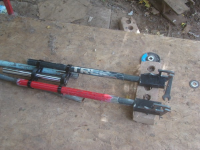Hey all, Finally putting dual motors on my CETMA cargo bike (currently running a GMAC10T on 26" rear rim). On the front right now I have a 36 spoke 20" BMX wheel and I am trying to sort out my best path moving forward to add motor #2 to the front hub.
This is a HEAVY bike, with all the extras and add-ons its >100lbs empty. With a 220lbs rider, and some cargo it easily and routinely is exceeding 400lbs loaded and on some occasions is >500lbs (part of the reason I want to move to twin motors.)
I was planning on going to a Grin with Fast windings (on the existing custom 10s LiFePo4 50Ahr pack 32-36V) HOWEVER I just realized that the Grin motor only has 32 spoke holes and I'm a bit sketched out as to if that's a hot idea or not considering the loads this bike is under...
Do you mean another GMAC? Or a different Grin motor?
The GMAC has 36 spoke holes according to this:
GMAC Clutchless Geared Hub Motor, Standard (8.1 rpm per V) Winding. Full Product Information Page

ebikes.ca
as does the one I've got on a shelf awaiting the redesign/rebuild of my SB Cruiser heavy-cargo-trikes' leftside rear frame to accomodate the axle width and gear cluster, etc.
If you mean the Grin All Axle motor,
Custom Build of Fast Wind (12 rpm/V) All-Axle Hub MotorFull Product Information Page

ebikes.ca
that does have 32 spoke holes in the flange, and due to the flange design cannot really be drilled out for more holes.
I don't think you need it, but if you really want a 36 hole wheel with the GAA, you could have flange adapter rings designed and made that bolt to the existing flange spoke holes (or side cover screw holes), that have whatever spoke hole pattern you'd like to use. This would also allow a slightly wider bracing angle if desired. Or go all out and have new side covers made that replace the existing ones, since unlike most motors, the flanges are part of the side covers and not the rotor. You could even ask Grin if they could do this for you (I'm sure it wouldn't be cheap), or maybe if they could supply you with the data necessary to easily make/modify a CAM file to have it done. (not sure if they'd provide that data, as if it escaped into the wild it would make the motor simpler to visually counterfeit, and there's enough of that already out there).
Alternately, there are these wheels
Custom Build of All-Axle Hub Motor into 20

ebikes.ca
I've never tried "mag" wheels in these types of situations, but these are designed for cargo bikes, so...they ought to be good enough. Haulincolin made spokeless flange adapters for his heavy cargo bike here:
I've read the threads about solid rims / mag wheels / people breaking spokes. I'm well aware that a traditional spoked wheel has many advantages and a way better strength to weight ratio than a mag wheel ever could. I'm on board with Chalo's explanations about spoke tension and stretch and...

endless-sphere.com
so I'd guess they should be ok as a general concept.
If you stick with a spoked 20" wheel, then as well as 20" BMX rims, you can also use 16" moped rims if you like, some of them come in 32 hole. Many of the 20" bicycle rims will mount a 16" moped or MC tire of appropriate width for that rim, and vice-versa...but there are at least three sized of "20"" rim:
| 20" BMX / Kids | 406 | ISO 406 Tires |
| 20 x 1-3/4" | 419 | ISO 419 Tires |
| 20 x 1-3/8", 20 x 1-1/8" | 451 | ISO 451 Tires |
So make sure you get the one you need for the tire size you want to use. (a bicycle tire should be marked for the ISO number it will fit as well as the "imperial" measurements). One article on this
https://www.westernbikeworks.com/tire-sizes-article .
AFAICR the 20" rims I'm using on my SB Cruiser trike fit 406 bicycle tires. I used a number of bicycle tires before switching to 16x2.25" Shinko SR714 moped tires some years back (for the better grip and significantly better puncture protection...it's a huge PITA to deal with a flat on a loaded heavy-cargo trike, especially if the cargo is a wiggly Saint Bernard!).
If you get a moped (or any other) rim make sure it is at least a doublewall, not single wall.
Would love to get opinions as to if it would be preferable to stick to some super duper 36H BMX rim but lace it to the 32H Grin, or if I would be better off going to 32H and 32H or move to a 36hole motor.... Is the GMAC able to be used as a front hub motor????
Sure--you just have to use a fork wide enough to accomodate a rear motor, such as some Fatbike forks. I used a (inadequate, as it turned out, see last pics) fatbike fork on the front of SB Cruiser to mount a rear 26" Stromer wheel with an Ultramotor in it. Didn't get the chance to wire up the motor and use it as the fork was too weak for the application and rapidly began to deform from simple braking forces. But you can get (or make) a fork that could do it. If you are using disc brakes you need to make sure the mounting tabs on the fork still line the caliper up with the rotor, or that you can get or make an adapter for this.
The way it started out was fine
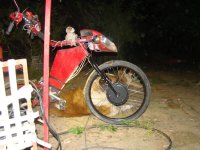
and the caliper even lined up right
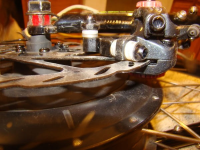
but a week's riding later it looked like I'd mounted it backwards (because of the bending at the crown)


Surly forks are probably built heavily enough, so if they make a fat fork with the right dropout spacing for the GMAC I'd ask them if they think it will handle the braking forces of your bike+rider+cargo mass at the speeds you intend.
If you want to make one, just get some triple-tree / double-crown clamps for a fatbike fork width with the right steerer tube for your headtube/headset, and some pedicab dropouts (heavier duty and will probably handle the motor torque better) with brake mounting tabs for the caliper, and install the necessary tubing in the clamps (old bike frames, etc; I just doubled up the tubing from two slightly different size tubes of bike frame down/top tubes I had laying around to make mine, though my present one isn't a fat fork as I only have standard width clamps).
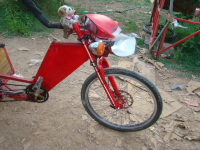
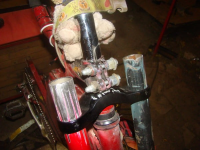
Since I am saving the pedicab dropouts for a fork with a motor in it (once I find some wide enough clamps for the stanchions that are cheap enough), I did the simple hack of slipping an old crappy steel fork's stanchion lowers over my actual stanchions, and shimming and welding it on (as I don't have any suspension).

I did have a plan to make ends for the stanchions to hold the pedicab dropouts and use it to mount a rear wheel anyway, but I went with the other because I really just needed to get it back on the road and I was sick.
